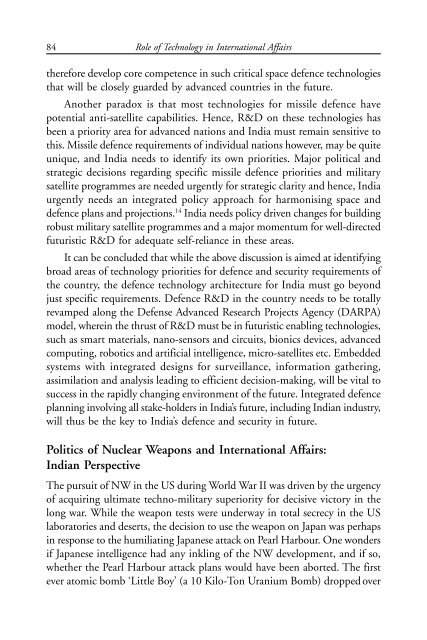ROLE OF TECHNOLOGY INTERNATIONAL AFFAIRS
book_role-of-technology-in-international-affairs_a-mallik_1
book_role-of-technology-in-international-affairs_a-mallik_1
Create successful ePaper yourself
Turn your PDF publications into a flip-book with our unique Google optimized e-Paper software.
84<br />
Role of Technology in International Affairs<br />
therefore develop core competence in such critical space defence technologies<br />
that will be closely guarded by advanced countries in the future.<br />
Another paradox is that most technologies for missile defence have<br />
potential anti-satellite capabilities. Hence, R&D on these technologies has<br />
been a priority area for advanced nations and India must remain sensitive to<br />
this. Missile defence requirements of individual nations however, may be quite<br />
unique, and India needs to identify its own priorities. Major political and<br />
strategic decisions regarding specific missile defence priorities and military<br />
satellite programmes are needed urgently for strategic clarity and hence, India<br />
urgently needs an integrated policy approach for harmonising space and<br />
defence plans and projections. 14 India needs policy driven changes for building<br />
robust military satellite programmes and a major momentum for well-directed<br />
futuristic R&D for adequate self-reliance in these areas.<br />
It can be concluded that while the above discussion is aimed at identifying<br />
broad areas of technology priorities for defence and security requirements of<br />
the country, the defence technology architecture for India must go beyond<br />
just specific requirements. Defence R&D in the country needs to be totally<br />
revamped along the Defense Advanced Research Projects Agency (DARPA)<br />
model, wherein the thrust of R&D must be in futuristic enabling technologies,<br />
such as smart materials, nano-sensors and circuits, bionics devices, advanced<br />
computing, robotics and artificial intelligence, micro-satellites etc. Embedded<br />
systems with integrated designs for surveillance, information gathering,<br />
assimilation and analysis leading to efficient decision-making, will be vital to<br />
success in the rapidly changing environment of the future. Integrated defence<br />
planning involving all stake-holders in India’s future, including Indian industry,<br />
will thus be the key to India’s defence and security in future.<br />
Politics of Nuclear Weapons and International Affairs:<br />
Indian Perspective<br />
The pursuit of NW in the US during World War II was driven by the urgency<br />
of acquiring ultimate techno-military superiority for decisive victory in the<br />
long war. While the weapon tests were underway in total secrecy in the US<br />
laboratories and deserts, the decision to use the weapon on Japan was perhaps<br />
in response to the humiliating Japanese attack on Pearl Harbour. One wonders<br />
if Japanese intelligence had any inkling of the NW development, and if so,<br />
whether the Pearl Harbour attack plans would have been aborted. The first<br />
ever atomic bomb ‘Little Boy’ (a 10 Kilo-Ton Uranium Bomb) dropped over


